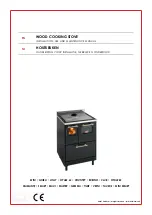
Emptying Ashes
Only empty ashes when the fire is cold. Use the tool or a glove to open the door. Stir the fire with a poker before lifting out the ashbin. Remember to let ash
cool before disposing in plastic sacks or dustbins. There is no need to empty every last speck but ash from mineral fuels should never be allowed to build up so
that it comes into contact with the underside of the grate.
Extended Burning
Our stoves are intended for quick heat-‐up intermittent use. While well capable of lasting for many hours, they are not designed for overnight burning. For best
extended burning results allow the fire to burn down to a low, hot, firebed and fully fill with a hard fuel such as anthracite (c30mm size is best) and set the air
controls to ‘low’.
Keeping the window clean
Simply operating the stove for a few minutes at high output will often burn off any deposits left by tarry or wet fuels. Severe stains can be removed when cold
with a domestic bleach cleaner. The window is not glass but a transparent ceramic, it may develop tiny hairline cracks, these are harmless and a characteristic of
the toughest heat-‐resistant material known. Reduce the risk of staining by using only very dry fuel and keeping the airwash ❷control at least a little open.
Opening the door
This stove is designed to be operated only with the door closed. The door handle can get very hot so use the poker tool or a glove. Open the door very slowly to
minimise fume emission and prevent hot fuel falling out.
Summer shut down
Before a long period of non-‐use, empty fuel and ash, remove the throat plate and leave all air controls open to allow ventilation and reduce condensation.
Fuels
There is no ‘perfect’ fuel so we strongly recommend that you try a selection of fuels (or mixtures) to find which
suits you best. Do avoid dusty materials such as sawdust, they can burn far too violently.
Smoke Control
In certain areas special rules apply to reduce smoke nuisance. Check with your local authority.
Wood
Wood only emits as much carbon to the atmosphere as the tree took in when growing so wood is considered
the ‘carbon neutral’ fuel. When wood is cut down its cells are full of water. Burning such wet or ‘green’ wood
wastes heat in making steam and produces flammable acidic tars which will cling to, and rapidly damage, your
stove and chimney. Split logs will typically take two years to become reasonably dry, round logs much longer.
Cracks in the ends, a hollow sound when tapped and bark falling away are all signs that a log may be ready for
use. The fine, white residue produced when wood burns is not ash, but the remains of cell walls which can burn if
kept hot enough, so don’t de-‐ash a fire until absolutely necessary when using wood.
These appliances are authorised for use in smoke control areas of the UK when burning wood. For best performance, and always for low smoke emission:
•
Split logs lengthways for drying
•
Use logs no bigger than about 100mm x 250mm
•
Ensure logs are absolutely dry (less than 15% moisture)
•
Fill the stove ‘criss-‐cross’ so air can circulate between logs
•
Fill ‘little & often’
•
Always have the airwash control ❷ at least a little open
•
When first lighting, or reviving a fire from embers, use only very small, thin, dry, sticks
•
Never operate with the door open
•
Don’t overfill the firebox
Joinery Waste
Dry wood offcuts will burn well, but don’t expect softwood waste to burn as cleanly or for as long as hardwood logs.
Peat
(Not smokeless in the UK. Smokeless in the RoI) Sod turf must be thoroughly dry.
Lignite
(Not smokeless) A natural mineral, between peat and coal. It lights easily and burns well, but produces much ash.
Housecoal or Bitumous coal
(Not smokeless) Makes a lot of tarry smoke and large volumes of flammable gas which makes it difficult to control and risk explosions. Despite its low cost it
rarely represents good value for money. Never use housecoal.
Anthracite
(Smokeless) A natural hard, shiny form of coal. Slow to light, it can burn for very long periods with great heat. Despite its high price per bag it generally works
out to be one of the cheapest of all fuels. Use the small ‘nuts’ size.
Coke
(Smokeless) Coke is coal from which the smoke has been removed. Sometimes difficult to light, it burns very cleanly.
Briquettes
Compressed blocks of fuel, generally able to burn for long periods and remarkable for their consistency. ‘Homefire’ and ‘Phurnacite’ are smokeless types while
other brands are made from lignite, peat or housecoal.
Petroleum Coke
(Smokeless in the UK, forbidden in smokeless zones in the RoI) Sold as ‘Petcoke’, ‘Longbeach’ and under various proprietary names, is made from oil. Easy to
light and control, its exceptional heat and lack of protective ash mean that it MUST NOT be used unless mixed with another fuel. Grate and liner life will be
drastically reduced when using petroleum coke.
Household Wastes
Some plastics give off toxic fumes when burned and remember that batteries and aerosols explode! The stove is not an incinerator, so only use the
recommended fuels and NEVER use liquid fuels in any form.
Kiln dried beech logs of around
1.2kg are recommended for
optimum performance.


























